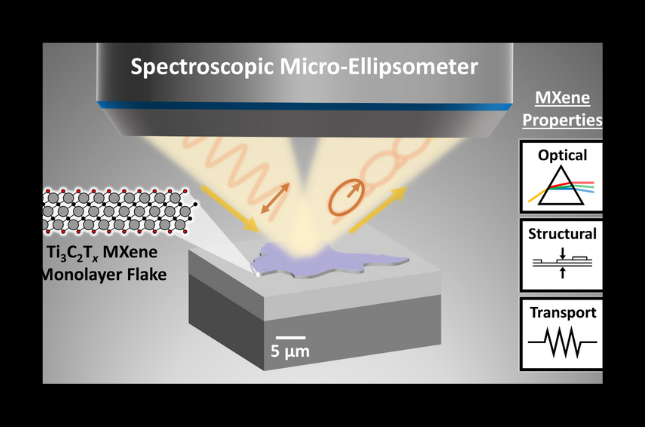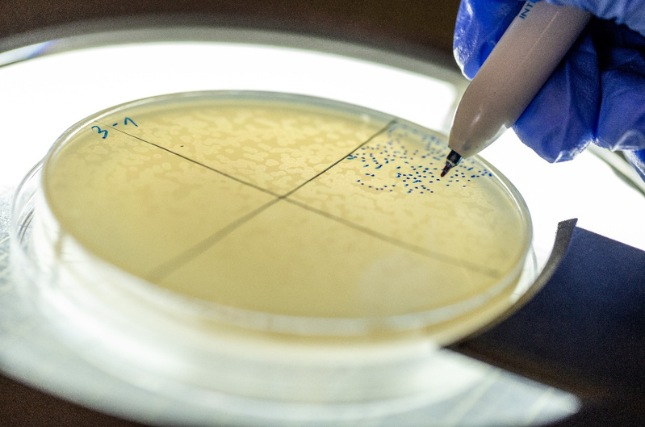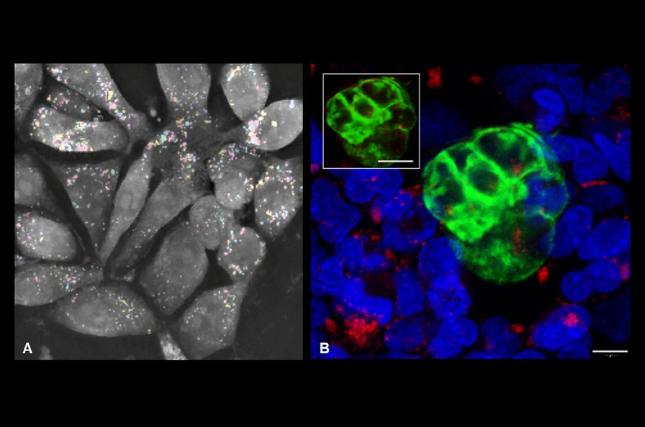
October 13, 2025 – Researchers have, for the first time, measured how a new atomic-sized nanomaterial, MXenes (pronounced max-eens), behaves using new technology, which could be essential to understanding how to design applications and devices that are both efficient and scalable.
According to the findings published in ACS Nano, the new technology to study MXenes is called spectroscopic micro-ellipsometry (also known as the SME technique). This novel light-based technique can look at how MXenes behave at the single-flake level, revealing changes in conductivity and optical response that were previously hidden when studying only stacked layers.
MXenes are ultra-thin materials just a few atoms thick, known for their ability to conduct electricity, store energy, and interact with light. Until now, however, most studies have examined MXenes in bulk form—as thin films made up of many overlapping flakes. That approach, while useful, masked the unique properties of single flakes, leaving unanswered questions about their true potential. MXenes are being explored for a wide range of applications—from ultrafast batteries and water purification systems to flexible electronics and solar energy harvesting.
The new study was conducted by Dr. Ralfy Kenaz and Prof. Ronen Rapaport from the Hebrew University of Jerusalem (HU) Racah Institute of Physics, together with Dr. Andreas Furchner and Dr. Tristan Petit from Helmholtz-Zentrum Berlin (HZB).
Dr. Kenaz, developer and co-inventor of the SME technique, said: “What is truly outstanding with this work is that in less than one minute, we can directly measure the optical properties, thickness, structural properties, and conductivity of individual MXene flakes—all in a non-destructive way. Normally, these measurements require three different instruments, are time-consuming and destructive, and in the end, not as reliable as spectroscopic micro-ellipsometry.”
Ellipsometry is one of the most advanced non-invasive optical techniques for material characterization. However, conventional ellipsometers inherently struggle to measure areas smaller than 50 microns—roughly the width of a human hair—making them unsuitable for analyzing the microscopic structures common in modern technology and research. As a result, ellipsometry measurements on MXenes have been limited to macroscopic thin films made of stacked, overlapping flakes. This limitation has prevented direct measurements of individual MXene flakes, whose lateral dimensions are much smaller, thereby hindering a true understanding of their intrinsic properties.
New Spectroscopic Micro-ellipsometry Developed
The advanced, patented technique, spectroscopic micro-ellipsometry, is essentially a type of “optical fingerprinting” that allows them to measure the optical, structural, and electronic properties of single MXene flakes with high lateral resolution and without damaging them. In the study, individual MXene flakes of varying thicknesses were synthesized in HZB and sent to HU for SME measurements. Complementary nanoscale measurements were performed at HU’s Nano Center, and all data analyses were carried out collaboratively by both groups.
By shining light with defined polarization states on microscopic flakes as thin as a single molecular layer and analyzing how that light reflected, the researchers mapped how the material’s ability to conduct electricity and interact with light changes depending on thickness and structural properties. They discovered that as MXene flakes become thinner, their electrical resistance increases—a critical insight for building reliable, high-performance devices.
The method was so precise that it matched nanoscale imaging tools such as atomic force microscopy and scanning transmission electron microscopy, confirming its power as a non-invasive diagnostic tool.
“This work provides a roadmap for integrating MXenes into real technologies by offering a direct view of their intrinsic properties, without the interference of stacked layers or impurities,” Prof. Rappaport says. “By refining how we study these materials using our SME technique, we are paving the way for their use in optoelectronic devices, energy solutions, and beyond.”
The study not only unlocks fundamental knowledge about MXenes but also establishes spectroscopic micro-ellipsometry as a new standard for analyzing 2D materials. With this breakthrough, scientists worldwide may soon gain the ability to probe other emerging nanomaterials in the same way.
Dr. Petit concludes, “This is a powerful demonstration of how international collaboration and advanced physics can accelerate materials science. MXenes are just the beginning.”
The research paper titled “Optical, Structural, and Charge Transport Properties of Individual Ti3C2Tx MXene Flakes via Micro-Ellipsometry and Beyond” is now available in ACS Nano and can be accessed here.
Researchers:
Ralfy Kenaz1, Saptarshi Ghosh1, Mailis Lounasvuori2, Namrata Sharma2, Sergei Remennik3, Atzmon Vakahi3, Hadar Steinberg1,3, Tristan Petit2, Ronen Rapaport1 and Andreas Furchner2
Institutions:
- Racah Institute of Physics, The Hebrew University of Jerusalem
- Helmholtz-Zentrum Berlin für Materialien und Energie GmbH, Nanoscale Solid–Liquid Interfaces, Schwarzschildstraße 8, 12489 Berlin, Germany
- Center for Nanoscience and Nanotechnology, The Hebrew University of Jerusalem




